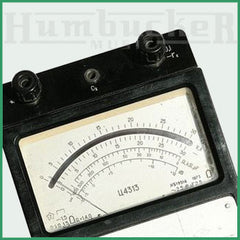What is tube amp bias?
 What Exactly Is Bias?
What Exactly Is Bias?Before we talk about different types of biasing found in tube amps, it is probably a good idea to explain what exactly the bias is. The best way to understand bias is to think of it like the idle setting on a car. Nowadays most cars have complex computers that control the idle, however, in the end the process is still basically the same as it has always been. The fuel and air mixture is adjusted so that the motor runs smoothly; too much of either and the motor won't run very well or even possibly not at all. The idea is to find the perfect balance for optimum performance. When it comes to tube amps the idea is basically the same, however, instead of fuel and air we are dealing with electrical current. The purpose of setting the bias of an amp is to find the optimum setting for the flow of current when the amp is idling. Too much and the life of a tube is significantly decreased and in extreme cases failure can occur; this is also referred to as "biased hot." Too little and unpleasant distortion (crossover distortion) is produced; this is referred to as "biased cold." The correct setting is crucial for an amp to perform at its best both functionally and soundwise.
Why Is It Necessary?
So if there is an optimum setting, why not just set the bias to that point and leave it? That would definitely make the most sense, but the problem is it's not really that simple. It's more akin to a moving target than an exact point. Think of it as an acceptable range, not one single point. The reason for this is that each set of tubes is going to have different performance characteristics that will affect how the bias should be set. Even within a single brand of tubes you will find one set that may vary wildly from the next in terms of it's operating characteristics. Unfortunately, that is one of the realities of vacuum tube production and honestly it has been since the beginning. For this reason, when changing power tubes in a tube amp it may be necessary to set the bias on the amp to make sure it is optimized for the new set of tubes and not the set you just replaced.
Tube Amp Bias Types:
There are a few different ways that the bias is set on an amplifier and some are more involved than others, though it is hard to say that one is really better than the next. Here are few of the more popular types found in tube amps:
Cathode Bias
Cathode bias amps are the least work intensive, as they do not really require biasing at all in a general sense. Many people actually refer to them as "self-biasing" for this reason. Without getting into too much technical detail/jargon, basically through a series of design characteristics - mainly a resistor - these amps balance themselves against the current draw of a given set of power tubes. For this reason, they will normally function pretty well with a wide range of tubes without needing any adjustment. It is basically "plug and play," however, we would still recommend buying a matched set of tubes for optimum performance. Cathode biasing is very commonly found in lower powered amplifiers and even more so in amps that use EL84's. Unfortunately, the design is a bit difficult to incorporate in higher powered amps, which is one reason for the limited use in tube amps.
Adjustable Fixed Bias
Adjustable fixed bias certainly sounds like an oxymoron, but it is actually the best way to describe this type of biasing. Basically, the bias is pre-set to a fixed point based on the performance of a given set of tubes. Normally a tech will take a series of readings while the amp is idling in order to establish the proper amount of current a tube should be drawing and then via an internal adjustment pot he/she will set the bias based on this information. It is actually not an extremely difficult process, but can be very dangerous if you do not know what you are doing, as it often requires a person to take internal readings while an amp is plugged in and turned on. With this method of biasing it is recommended that the bias be checked after replacing the power tubes, unless the new set of tubes is identical to the set being replaced.
Non-Adjustable Fixed Bias
With this type of biasing, as the name would imply, the bias can't be easily adjusted. It is pre-set to a fixed point by design to work with a pretty wide range of tubes. As with cathode biasing, it is basically plug-and-play, however the results will vary slightly given the different operating characteristics of each set of tubes. For this reason, it may be advantageous to look for tubes that are graded or matched based on different characteristics. Being that it is difficult to optimize the amp for the set of tubes like with the other two methods, it is more important to optimize the tube to the amp in terms of operating characteristics.
A Quick Note About Tube Matching:
As we mentioned before, vacuum tubes by their nature tend to vary quite wildly in terms of operating characteristics. For this reason, it is definitely recommended when you change power tubes that you do so in matched sets. Though it is completely okay for one set of tubes to have different characteristics from another set, it is pretty important that all the tubes within a set have values that are pretty close. For this reason many companies buy tubes in bulk and will test, match and grade tubes. One advantage to this is that any tubes that have a less than favorable performance are disposed of. You also kind of know what to expect from a set of tubes before you pop it into your amp. For players with adjustable fixed bias amps this also eliminates the need to re-bias after every tube change as long as you replace the tubes with a set that has a similar performance rating.
Mesa Boogie not only makes cutting edge tube amps, they also have a state of the art tube testing/matching program:




